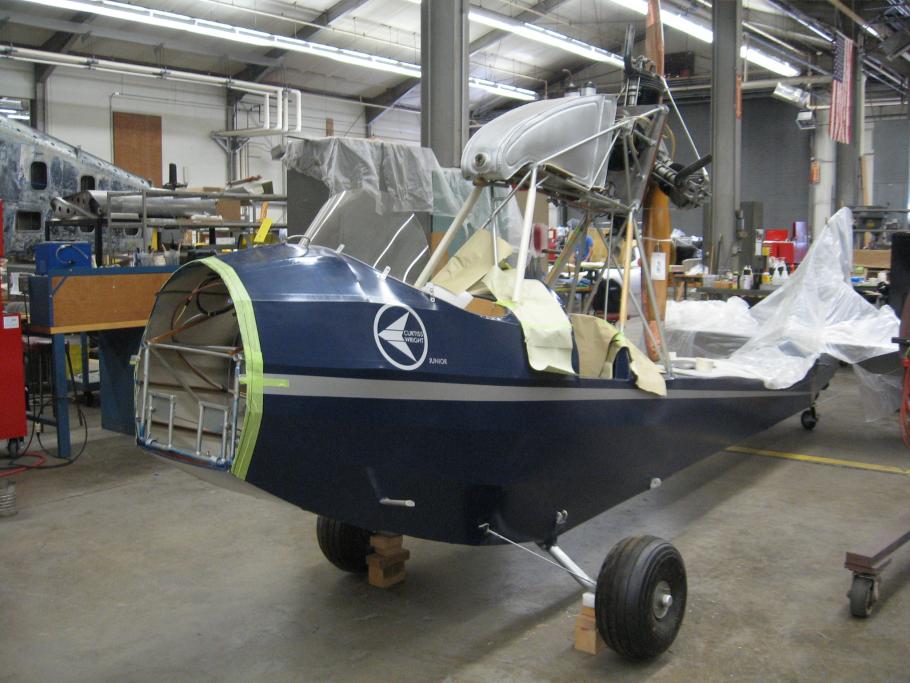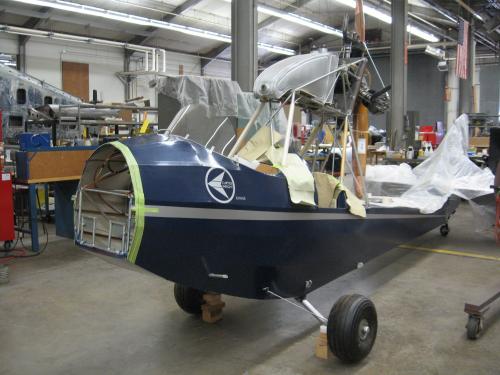The CW-1 was a moderate-priced, sport aircraft produced before the Depression for mass-market appeal. Smaller and simpler than cabin aircraft such as the Curtiss Robin, Curtiss-Wright designed the Junior especially for the low-budget sportsman pilot and the fixed-base operator who wished to offer flying time at a rate within reach of the average flying populace. Easy to buy, easy to fly, and cheap to operate, the Junior soon became just about the most popular flivver-type airplane of the next few years.
The CW-1 grew out of a late 1920s wood structure, parasol monoplane design called the Buzzard, designed by Orval H. "Bud" Snyder, which was powered by a 2-cylinder ABC Scorpion engine. Interestingly, Snyder worked with Jean Roche in the engineering division at McCook Field in Dayton, Ohio, and both of them independentnly designed light planes in their spare time. In 1930, Ralph S. Damon and Walter Beech, executives of the Curtiss-Robertson division of the Curtiss-Wright Corporation (Curtiss-Robertson became the Curtiss-Wright Airplane Company), decided to market a light airplane to compete with the Aeronca C-2, Roche's design, and the American Eaglet which were about to come on the market. They obtained the design rights to the Buzzard, but the aircraft had such poor performance that it had to be redesigned.
The three persons credited with the certificated design of the Junior, Karl H. White, Walter Beech, and H. Lloyd Child, labored to first produce the Skeeter, powered by a 3-cylinder 45 hp Szekely SR-3-O engine. The Skeeter's only resemblance to the Buzzard was that it was a pusher-type monoplane. It was first test-flown in October 1930, but engineering problems had to be solved before it would be ready for production. Later in the year the Skeeter was renamed the Junior and by December the aircraft was again test-flown and pronounced ready for production. The production Juniors were two-place, open cockpit parasol wing monoplanes, powered by the Szekely SR-3-O engine. By June 1931, 125 Juniors, each priced at $1,494, had been sold. It is estimated that at least 270 were built through 1931 and that 261 of those were issued registration numbers.
Company promotional material attributed the aircraft's success to price ("built to sell for the price of an automobile in the medium price class") and quality. The Junior had many admirable qualities: easy and safe in flight, short field capability, low handling speed, sturdy construction, low wing loading, and good visibility for the pilot that gave "amateur pilots factors which have hitherto been lacking in available airplanes." A pilot could take off in a Junior in as little as 200 feet and land in 250 feet; it cruised at 70 miles per hour and had an gentle stall speed of 35 miles per hour.
While much of this was true, the Junior had its problems. The Szekely engine was temperamental and had a habit of occasionally throwing a cylinder. This was solved by tying a steel cable around the cylinder heads, which although it could not keep the cylinder from being thrown, kept a thrown cylinder from being blown back into the propeller. Moreover, some accidents occurred on the ground when passengers in the rear cockpit walked into the propeller after deplaning. The Junior was modified as an amphibian and called the Duck, but an accident in which a pilot was killed after he put the aircraft into a shallow, inverted dive seriously damaged the aircraft's reputation.
That accident and decreasing sales put an end to the production of the Junior. Orders had fallen off drastically between the middle of 1931 and the end of the year, and by early 1932, sales came to a halt. Meanwhile, Karl White left for the Naval Aircraft Factory and Walter Beech went to Wichita, Kansas, to form his own company. Curtiss-Wright officials in Buffalo, New York, terminated design and production of the Junior and the St. Louis plant began producing the T32 Condor instead. Curtiss-Wright's brief foray into the private aircraft market ended.
Despite its brief history, the Curtiss-Wright Junior is a significant aircraft in the NASM collection because it represents a milestone in the so-called "everyman" aircraft movement in the United States. This movement, which began before the Depression and lasted over a period of two decades, sought to produce a mass-market, affordable, personal aircraft that would appeal to the average American citizen. The Junior also represented a significant diversion for the Curtiss-Wright Corporation, which was almost exclusively oriented to the production of military and heavy commercial aircraft during that time in its history.
This Junior, serial number 1143, NC 10965, was built in the summer of 1931 but the early years are unknown. In 1934, Les Maudlin of Brownsville, Texas, received a renewed license for the Junior after work was completed on the wing - fixing loose aileron hinges, nuts and bolts and drag wires. The total aircraft flight time was listed as 636 hours. G.C. Acord of Dallas, Texas, who owned the aircraft in 1945 and 1946, had the airframe nearly rebuilt and recovered. L.M. Angevine and R.C. Christopher of Bainbridge, Georgia, bought the aircraft in 1950 and noted in 1954 that it had 127 flight hours "since new" and that the original log book was lost. He apparently did not have access to the 1934 report with earlier recorded hours.
During these years, the owners flew the Junior on air show circuit performing the "Flying Farmer" routine, a stunt in which a "bystander" attempts to fly the aircraft with comical but safe results (i.e. easy-to-fly aircraft). For this routine, the aircraft was modified by removing the fuselage fabric, painting the wings in bright polka dots, and adding a 45 hp Lycoming engine.
Robert E. Maytag of the Maytag Company, Newton, Iowa, bought the Junior in 1954 and flew it as a private sport plane before storing it for several years. He donated it to the Museum on June 22, 1959. Upon donation the flight hours were listed as 137 however, when added to the hours listed on 1934 paperwork this Junior appears to have a minimum of 773 flight hours on the airframe or at least the remaining original parts.
A volunteer restoration team working one day a week restored the Junior to its original configuration from 2001 to 2012. Once again the wings needed rebuilding as did the nosebowl, mud flaps and more. Juniors originally came in red or blue, both with silver wings; blue paint was found on the steel tube frame and so it was painted blue. Goodyear Aviation donated Goodyear balloon tires, Tom Murphy of Oregon donated seats belts, and aircraft restorer Ken Hyde donated a Szekely engine and Flottorp propeller; several other parts or plans for them came from owners of the few remaining Curtiss-Wright CW-1 Juniors.
























